Advance Electronics
Advance Electronics Ltd. of Bishops Stortford, England, made several models of hand-held calculators, starting with the Executive in summer 1972, and desk calculators. Some of the models were produced as self-assembly kits, and some were manufactured and labelled for Phytron Electronics and Fi-Cord.
The philosophy of the company was stated to be to give "reliability and value for money rather than such dubious advantages as extreme miniaturisation".
Advance Electronics 'Ruby' calculators - Several calculators are known under the name 'Ruby' and labelled 'Advance Electronics Co. Ltd.' on the back. These machines were manufactured in Taiwan and do not appear to be related to Advance Electronics Ltd. of Bishops Stortford. See examples in the Photograph Gallery. If you have any information about these calculators please get in touch.
Click here for company details.
Known Advance models -
Desk Calculators -
- Wireless World Kit Calculator
- 16-R - Has one memory & square root.
- 161 (aka 16-1) - Has one memory.
- 161R - Has one memory & square root.
- 162P - Programmable.
- 162R - Has two memories & square root.
- Analysis 14 - has 14 memories accessed by a grid of keys! See Phytron Analysis 14.
- Executive 16
- Executive 16+2 (aka 162) - Has two memories.
Hand-held Calculators -
- 80
- 82R / Phytron 32
- 88
- Executive 8
- International Calculator kit
- Mini Executive
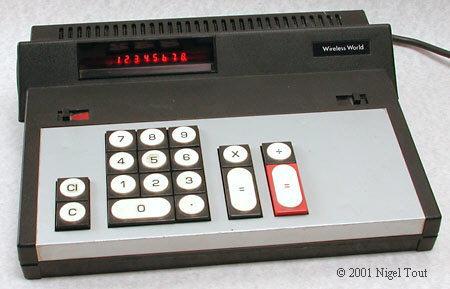
The slide switch at top left is to adjust the display brightness to one of three levels - an unusual feature.
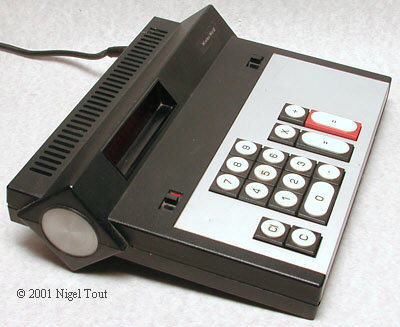
Side view showing the unusual shape.
Advance/Wireless World desk calculator kit.
8 Digits, red LED
4 functions.
252 mm x 200 mm x 72 mm (10" x 8" x 3").
Integrated circuit is the Texas Instruments first "calculator-on-a-chip", the TMS1802, here date coded week 38 1971. All calculator functions are provided in the single Large-Scale Integration (LSI) integrated circuit
Assembled from a kit produced by Advance Electronics in conjunction with the electronics and radio magazine "Wireless World". Details appeared in the September & October 1972 issues.
The cost
was £39.25 Sterling [about US$100].
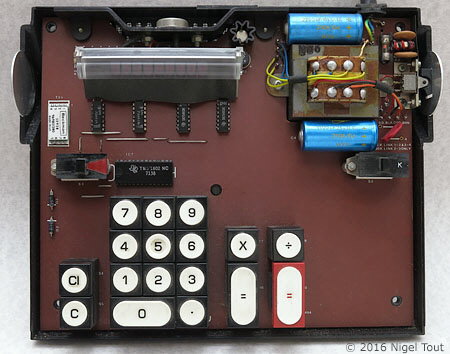
The circuit board showing, just above the keys, the calculator integrated circuit, the Texas Instruments TMS1802 "calculator-on-a-chip".
Far left is the white, hybrid thick-film integrated circuit with the clock generator circuit, which helps to reduce the number of components.
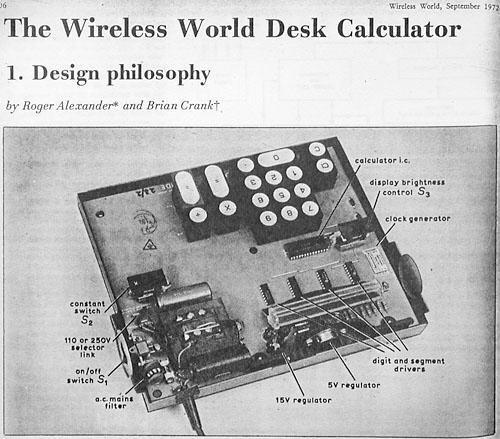
Calculator self-assemby kits:
Several electronics magazines featured calculator designs in the early 1970s, and several companies supplied calculator self-assembly kits, including Heathkit (see the Heathkit IC-2009) and Sinclair. These gave some cost saving and also the satisfaction of having assembled the calculator oneself.
The kit companies usually had a scheme whereby you could return the calculator
for sorting out if it did not work properly!
In Britain there was an extra price advantage for the kits since they did not attract the Purchase Tax which was applied to complete calculators. This advantage was lost from April 1973 when the all pervasive Value Added Tax (VAT) was introduced, which applied to almost all products.
Within a few years all there was inside a calculator was the integrated circuit chip, the display, and the keyboard. The assembly cost was very little so kits had no advantage and died out.
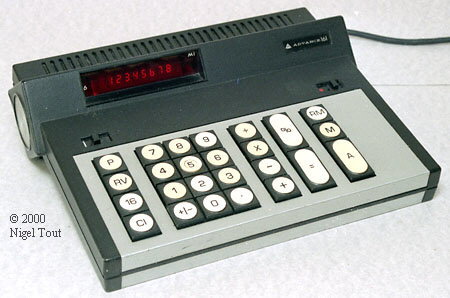
Advance 161 aka 16-1 desk calculator with one memory.
8 Digits, amber gas discharge behind red filter.
Will accept and calculate with 16 digits and display either the 8 most-significant digits or 8 least-significant digits as needed.
4 function, %, memory.
Main integrated circuits manufactured by General Instrument Microelectronics. They have the Advance Electronics "A" logo printed on them, so may be custom designs.
252 mm x 200 mm x 72 mm (10" x 8" x 3").
One display integrated circuit date-coded early 1973.
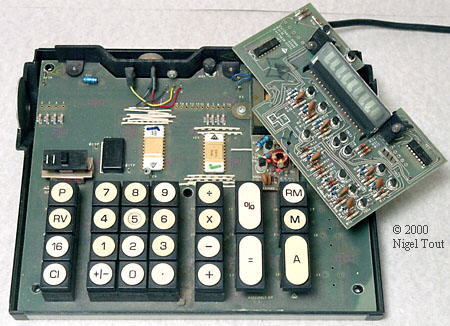
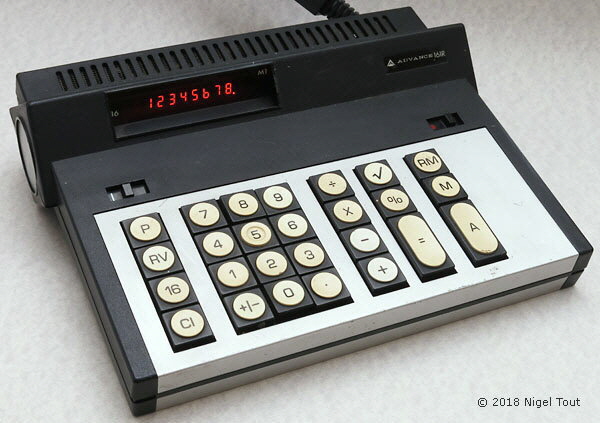
Advance 161R desk calculator with one memory and square root.
8 Digits, Panaplex II amber gas discharge display behind red filter.
Will accept and calculate with 16 digits and display either the 8 most-significant digits or 8 least-significant digits as needed.
4 function, %, square root, memory.
The two main integrated circuits have the Advance Electronics "A" logo printed on them. One is the GIM4 from General Instrument Microelectronics, and the other (date-coded week 11 of 1974) has the part number H52973 and no indication of manufacturer, so may be a custom design.
252 mm x 200 mm x 72 mm (10" x 8" x 3").
One IC date coded early 1973.
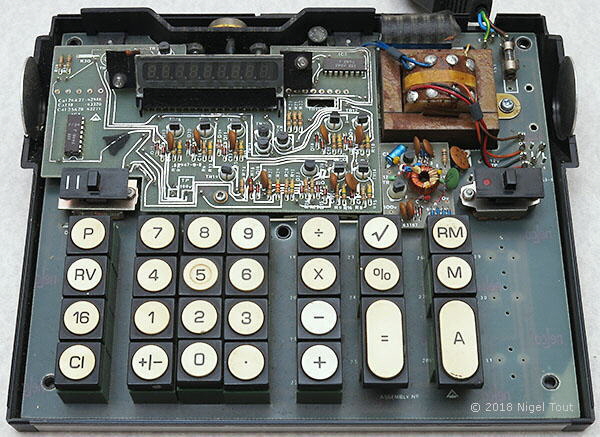
With the cover removed, showing the main circuit board with the display daughter board. The display is amber gas-discharge.
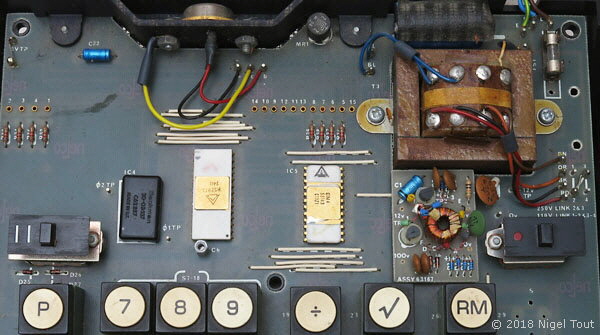
The display daughter board has been removed to reveal the main integrated circuits.
Both have the Advance Electronics 'A' logo, and the one on the right is a GIM4 from General Instrument
Microeletronics.
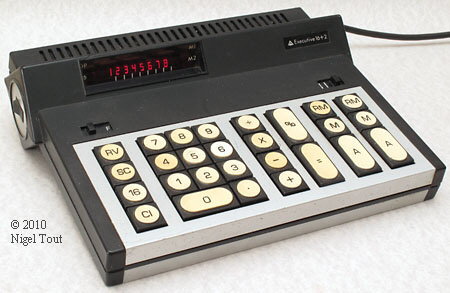
Advance Executive 16+2 aka 162 desk calculator with two memories.
8 Digits, red LED behind red filter.
Will accept and calculate with 16 digits and display either the 8 most-significant digits or 8 least-significant digits as needed.
4 function, %, two memories.
Main integrated circuits by General Instrument Microelectronics. They have the Advance Electronics "A" logo printed on them, so may be custom designs.
252 mm x 200 mm x 72 mm (10" x 8" x 3").
One IC date coded early 1973.
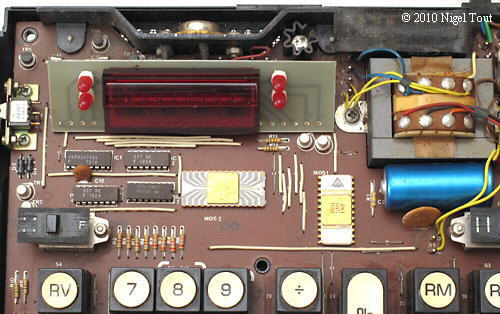
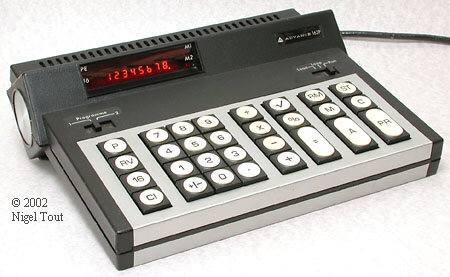
Advance 162P Programmable desk calculator.
8 Digits, amber gas discharge behind red filter.
Will accept and calculate with 16 digits and display either the 8 most-significant digits or 8 least-significant digits as needed.
4 function, %, memory, square root, programmable (2 x 40-step programs).
Main integrated circuits by General Instrument Microeletronics. They have the Advance Electronics "A" logo printed on them, so may be custom designs.
252 x 200 x 72 mm (10" x 8" x 3").
Chips are date coded 1974.
The price in 1974 was £199 Sterling (excluding VAT) [about US$460].
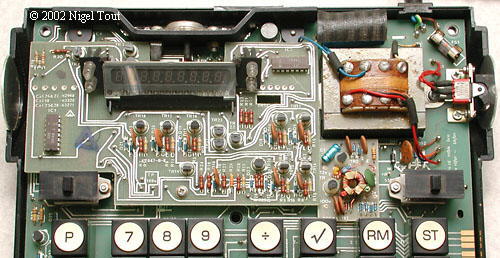
With the cover removed, showing the main circuit board with the display daughter board. The display is amber gas-discharge.
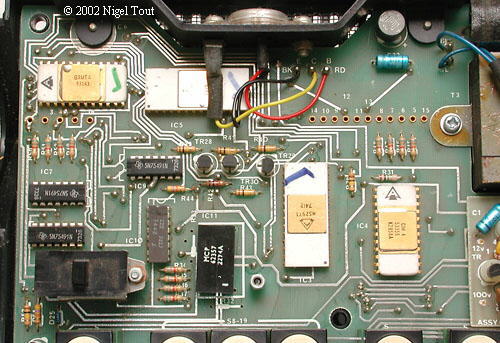
The display daughter board has been removed to reveal the integrated circuits.
The main ones are from General Instruments Microeletronics.
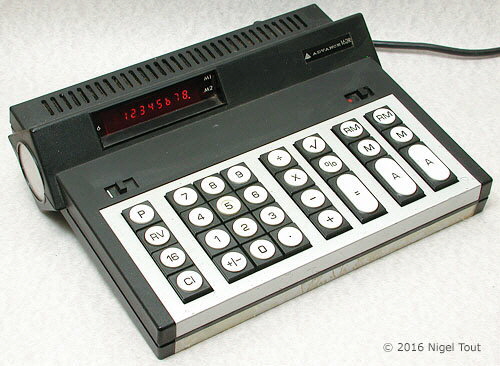
Advance 162R desk calculator with square root and two memories.
8 Digits, amber gas discharge behind red filter.
Will accept and calculate with 16 digits and display either the 8 most-significant digits or 8 least-significant digits as needed.
4 function, %, memory, square root, 2 memories.
Main integrated circuits by General Instrument Microeletronics. They have the Advance Electronics "A" logo printed on them, so may be custom designs.
252 x 200 x 72 mm (10" x 8" x 3").
Chips are date coded late 1973.
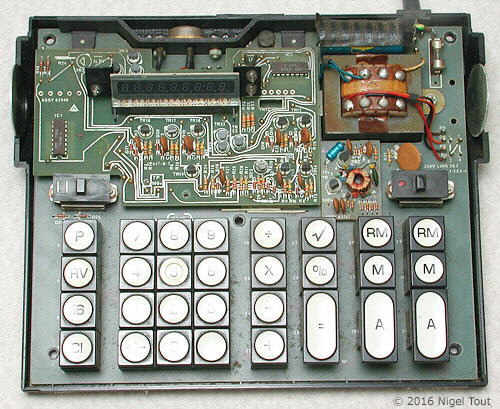
With the cover removed, showing the main circuit board with the display daughter board. The display is amber gas-discharge.
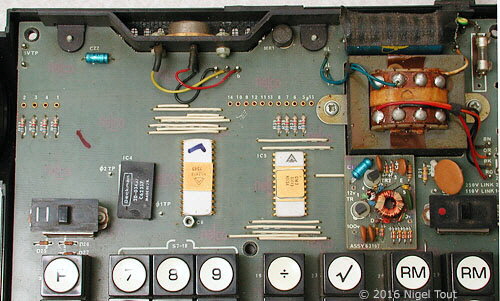
The display daughter board has been removed to reveal the integrated circuits.
The main ones are from General Instruments Microeletronics.
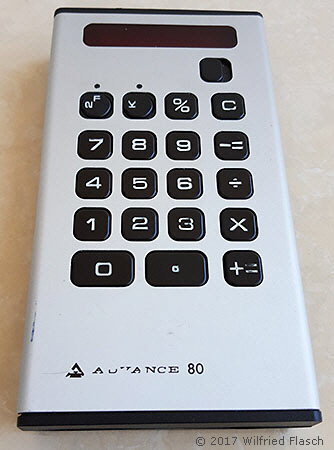
Advance 80
Display is 8 digits, red LED.
4-functions.
9v (6x AA batteries).
Main calculator integrated circuit: Texas Instruments TMS0128.
Similar to the Advance Mini Executive.
The decimal-point setting key (marked 2F) and the constant key (marked K) are unusual in that they have to be pressed in and rotated to set them.
The example pictured was marketed by Yizrael - R.D.T. Ltd., Israel.
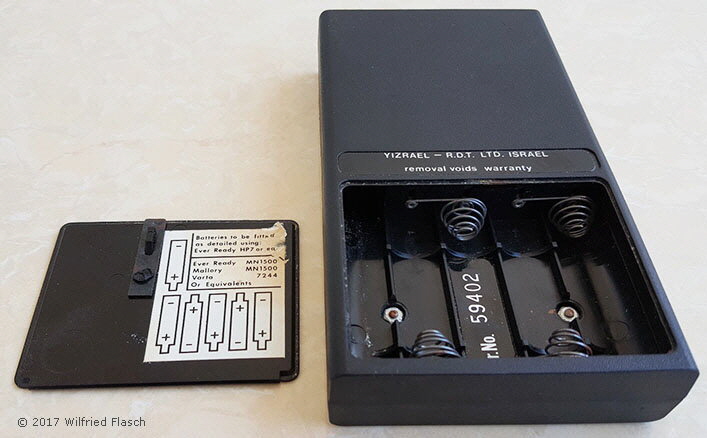
The battery compartment of the Advance 80, showing how the 6x AA cells were arranged. The requirement for such a large number of these cells is unusual.
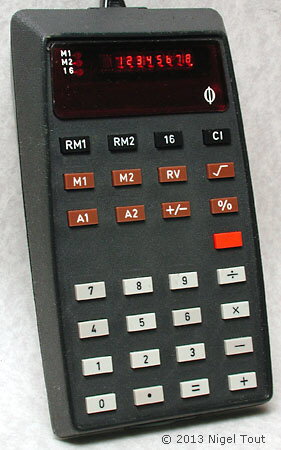
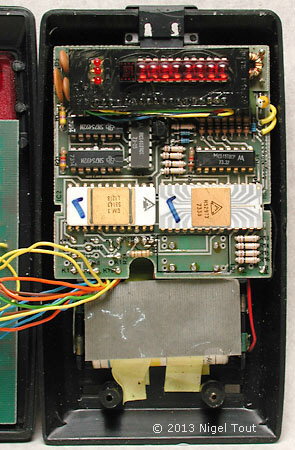
Advance 82R , aka Phytron 32
Display is 8 digits, red LED.
Four functions, %, 2 memories, square root. Can calculate to 16 digits.
5.5v (5x rechargeable AA batteries).
Main integrated circuits: General Instrument Microelectronics L1218 (here date coded to mid-1973), and an unknown manufacturer's H52973. Both have the Advance Electronics "A" logo printed on them, so may be custom designs. This circuit board is similar to that used in the Advance 88.
Size: 87 x 181 x 45 mm (3.4" x 7.1" x 1.75").
The selling price in 1974 was £136 GBP[3] [about US$320].
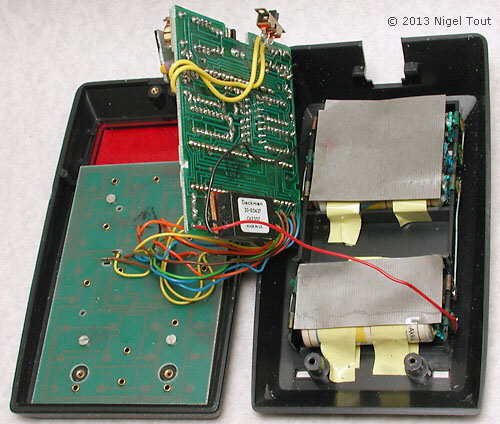
Underneath the circuit board are three more AA rechargeable cells, to give a total of five.
The publication "Electronic Calculator Markets and Suppliers", 1974, gives the price at £136 GBP[3] [about US$320], which is very high, but this example was bought at the Advance Electronics factory shop on 24th October 1975 for £10-80 [about US$25]. Although labelled as a Phytron 32 the invoice with the calculator describes it as an Advance 82R.
Graham Lewendon was for a time the only inspector on the hand-held calculator assembly line at the Advance Electronics Bishop's Stortford factory. Graham recalls:
"I clearly remember the
introduction of the Phytron 32 as it used a different keyboard made in house at the Bishop's Stortford factory. Also it was supplied with an internal set of rechargeable batteries, and the game we had getting the first products
made to fit together until we learnt the knack!"
There are more of Graham's recollections further down this page.
Note that this chunky model is unusual for a non-scientific hand-held calculator of this time in that it calculates to 16-digits, has 2 memories, and requires 2 main integrated circuits. The published price is very high (two ceramic packaged integrated circuits would be expensive) and it may have been sold off cheaply in 1975, by which time the cost of calculators had plummeted.
Click here for more information about Phytron calculators.
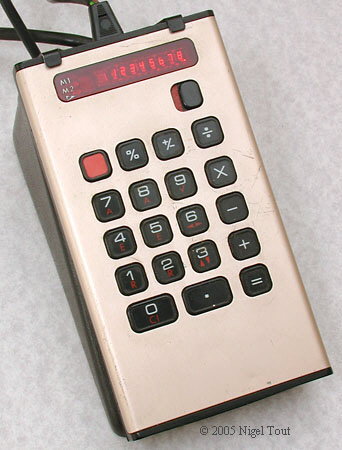
Advance 88 photographed mounted on the AC adapter unit.
The front of the casing is gold-coloured.
Advance 88
Display is 8 digits, red LED.
4-function, %, memory, square root.
Main integrated circuits - Advance H52973 and General Instruments/Advance GIMT4 (here date coded late 1973).
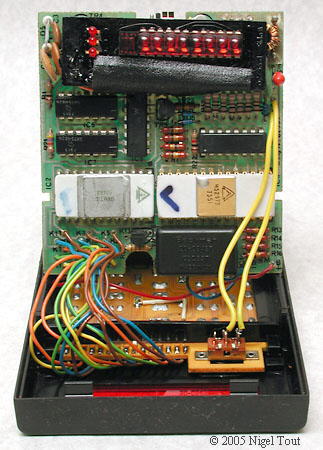
The cover has been removed to show the circuit board with the General Instruments/Advance GIMT4 and Advance H52973 integrated circuits in ceramic packages. This circuit board is similar to that used in the Advance 82R Phytron 32.
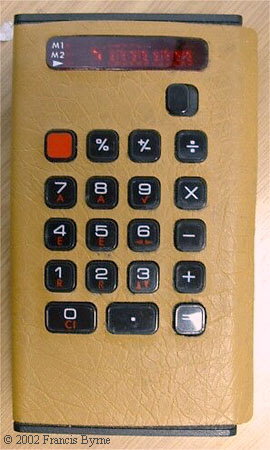
The version above has a very unusual leatherette cover to the keyboard. As Graham Lewendon explains below in his recollections of working at Advance, this was fitted due to problems in keeping the metal trim attached.
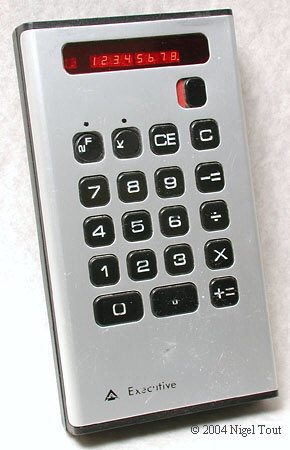
Advance Mini Executive
Display is 8 digits, red LED.
4-functions.
9v (6x AA batteries).
Main calculator integrated circuit: Texas Instruments TMS0103.
Introduced 1972.
Cost GBP £52.50 (about US$134).
Similar to the Advance 80.
The decimal-point setting key (marked 2F) and the constant key (marked K) are unusual in that they have to be pressed in and rotated to set them.
This model was developed as a self-assembly kit, see below.
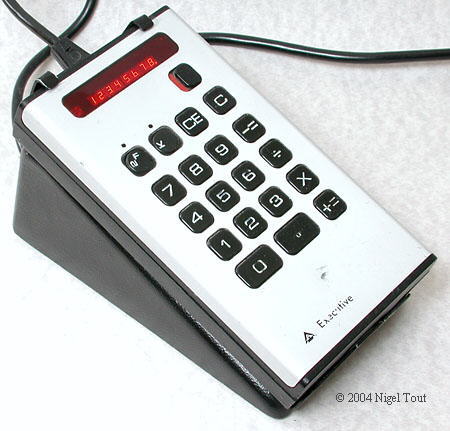
Mini Executive mounted on the AC adapter unit.
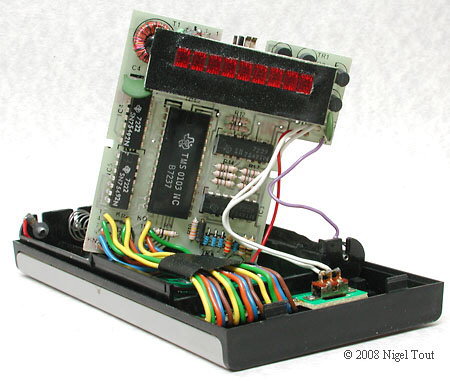
The circuit board of the Advance Executive, showing the LED display at the top and the large Texas Instruments TMS0103 calculator integrated circuit, here date coded week 37 of 1972.
The Advance Mini Executive, above, was developed as a self-assembly kit. In January 1974 an advertisement appeared in the journal Electronics Today International (E.T.I.)[1]:
"Now you can build your own hand-held calculator for £29.95. (In less than three hours.)
This calculator started life as the Advance Mini
Executive. For £57.75.
Then, in conjunction with E.T.I., we developed it, improved it—and now offer it to you for only £29.95."
- Company details
The following history is derived from information provided by Pat Meads, a former employee who was a production supervisor and was involved in the assembly of their first calculators, and from an archive of the website of Advance Electronics Ltd. at https://web.archive.org/web/20150710122538/http://www.aelgroup.co.uk:80/products/history.php:
The company was started by A.W. Stapleton in his garden shed. Advance Components Ltd. was formed on 24th March 1932, initially producing radio components, RF chokes, and small sub-assemblies, and soon entered the field of electronic test equipment.
In 1956 it moved from Walthamstow to larger premises in Hainault, Essex, and the company went public. The name was changed to Advance Electronics in 1964, and about 1968 it moved to a new factory in Bishops Stortford, and a
factory was also opened in Wrexham.
The five main business sectors were then:
- Metalised Film Capacitors, for the electronics, communication and automotive industries and in the group's own products. Manufactured in a plant at Wrexham.
- Industrial Electronics, control equipment, power supplies, constant-voltage transformers.
- Electronic Test Equipment, for industrial and research applications.
- Special projects, involving electronic systems.
- Printed circuit boards, for use by the group and under subcontract.
In 1971 the group had about 1100 employees, with distribution through 33 countries, and sales figures of around £3.4 million (about US$8 million).
Since then the company was bought by Gould, had a management buyout from Gould, merged with other companies, and demerged again.
It is still in existence, based in Wrexham, and specialises in Uninterruptible Power Supplies
(UPS), Power Conditioners, and related products.
Advance designed their machines with reliability in mind. As reported in the journal Electronics in May 1972[2] "To Briggs [calculator production
manager], the key is a machine that has a very low risk of going wrong and rarely needs servicing. "I know that some of our rivals dissipate most of their sales profits in servicing costs." he says.
"Others save money by providing poor service for unreliable machines, and those companies won't last. We believe that we genuinely won't need to spend much money on servicing. Once we've got a
reputation for reliability, [a lot of business] should come our way," he said.
"Advance's approach to reliability has been to use high quality components, where necessary built to Briggs' own specifications, and in
some cases with integrated functions, to push down the number of components used. The keys are sealed reed relays built initially by Alma Components Ltd. to an Advance spec. The clock circuitry contains a
temperature-compensated multivibrator integrated with other functions as a thick-film hybrid, and the power input is solid-state regulated. The eight-digit-plus-sign readout is a single light-emitting-diode module, which for
the larger machines is made complete with drivers by Fairchild and for the smallest machine is made with separate drivers by Texas Instruments.
Consequently Advance's part in making the machines boils down mostly to design,
assembly, and quality control. The test process includes a 48-hour bake at 50°C and a period on a vibration rig. Briggs reckons that, neglecting overhead, 95% of production costs are for materials and only 5% labor."
The semiconductor company General Instrument Microelectronics had a factory in Britain, in Scotland, and offered some custom design and manufacture. Advance appears to have taken advantage of this since the GIM integrated circuits used in most of their calculators are stamped with the Advance "A" logo.
The report "Electronic Calculator Markets and Suppliers", of 1974[3], says that Advance is "the third largest UK producer of electronic instruments. Electronic calculators account for nearly 20% of its sales, or £1M last year. It is technically perhaps more soundly based than Sinclair, but proportionally less interested in the mass market, with production of 20,000 units per annum."
Graham Lewendon was for a time the only inspector on the hand-held calculator assembly line at the Advance Electronics Bishop's Stortford factory, in Raynham road, from late 1973 until early 1975. He has kindly sent his very interesting recollections of his time with the calculators there:
"Examine the battery compartment on any of the silver calculators (known as cal 5 & cal 12 in factory). One version was a very simple model. The other had the % function. The gold trimmed units came with % and sq root function plus the twin memory. The inspection stamp ink is often yellow and of a solvent based ink and takes form of a number inside a triangle. If only I could remember my old inspection number. We used to place it between the ribs that separated each battery.
Re. your comments about the display of the advance 88. Yes it did display 8 digits, but it was a switched bank of 16, i.e. if the answer was 1.234567898765432 then pressing a manual selector switch displayed either one part of the answer or the other. We had a simple function test of 100 divided by 81 = 1.2345679. A more elaborate test being performed by test and trouble shoot engineers.
The silver and gold satin metal trims were so hard to keep attached to the plastic front case that simply placing thumb nail edge between lower curved corner where metal butted against plastic shoulder then twisting thumb nail (if it withstood this it passed inspection) could prise metal trim away from case. We tried many ways to prevent this lifting in the early days using a product we knew as IS12 or a thicker variant IS150, both being industrial super glue. After some time an improvement was made using thin double sided adhesive tape away from key pad area. This is reason for the fabric covered fronts [see the yellow Advance 88 above].
The red LED display had the black colour applied to the surround using nothing more than a black marker pen with the black tape over row or pin ends because the maker pen could not hide the metal end so it was used to make display look better than it really was. The 3 button LEDs on the left had the function of telling what part of the display was being shown plus which memory bank was accessed.
I clearly remember the introduction of the Phytron 32 [on the Phytron page] as it used a different keyboard made in house at the Bishop's Stortford factory. Also it was supplied with an internal set of rechargeable batteries, and the game we had getting the first products made to fit together until we learnt the knack!
I also recall the day we had some oriental gentlemen visit the production line and afterwards some of us felt that it was only a matter of time till our jobs disappeared. I seem to recall talk of whether we could encapsulate inner workings with epoxy resin to make reverse-engineering that bit more difficult. If only I knew then what I was only to learn 20 years later when making components for videojet ink jet print heads with 256 jets per head about epoxy resin and heat from a hot air gun! But we tried our best at the time.
There was always a problem with petty theft such that hand-held's product line had to move into what was known as the "glass house" thus preventing non-line employees reaching over high inward facing angled board and stealing parts to make their own calc.
We all went into work one day and with no prior warning the whole team was reassigned to build power supplies for Rank photocopiers but that's another bit of history. Looking at your site images turns the clock back a long time. Sorry that's all I remember after 25 years but I hope some of what I have shared with you is new to you.
References:
British calculators
Vintage Calculators
© Text & photographs copyright Nigel Tout 2000-2019 except where noted otherwise.